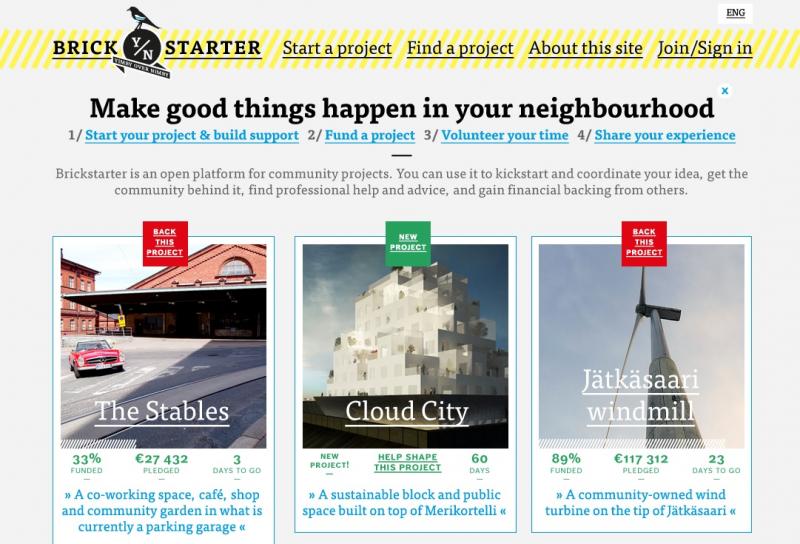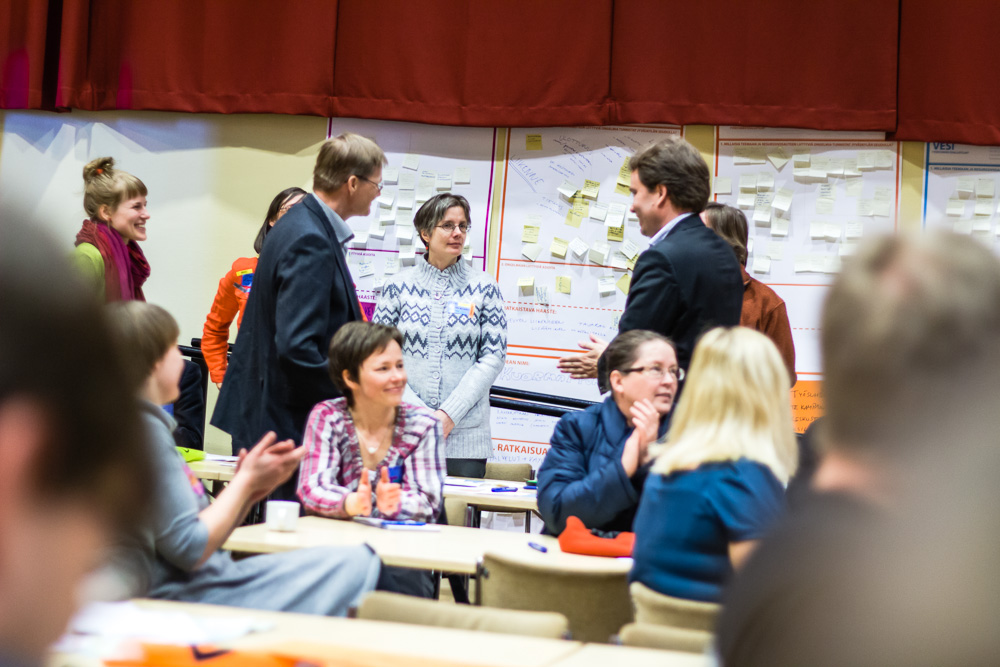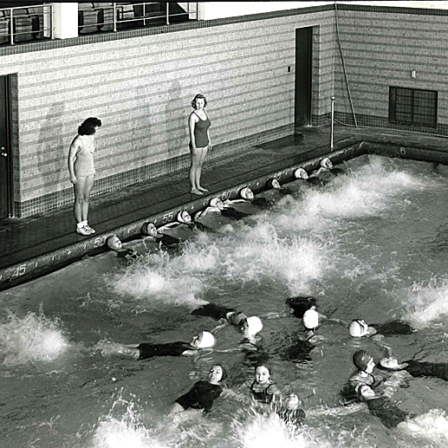Like seedlings, today’s small ideas can be nurtured into tomorow’s new solutions. This is possible through virtual websites and e-services. These can be used to collect ideas for enthusiasts and offer visibility for the people behind ideas. Communities enable their members to develop their living environment.
Interaction and open distribution of information are means to involve citizens in the development of their living environment. The more involved people are, the less simple-minded resistance they show. Inclusion builds shared responsibility. This is why the road from NIMBY to YIMBY goes through inclusion. The Not in my backyard community is heard easily, because until now the authorities have listened only to them, having offered feedback channels solely to complainers. If positive interaction is built through sharing, the more room there is for a Yes in my backyard kind of thinking. For this reason, it is important to offer concrete tools which help citizens and the authorities interact.
Direct public influence
Developed by Sitra’s design team, Brickstarter is a prototype of a website which communities can use to develop ideas together in order to bring positive change to their living environment. The idea arose from the desire to turn wishes and new service methods into reality by prototyping them.
Prototyping, a service design concept, means the creation of a sample service for testing purposes. The basic idea was the fruit of some fervent thinking and the search for human-sized solutions. No actual website has been created yet. Instead, the website exists as a prototype, setting an example which encourages people to launch similar practices in their communities. Brickstarter is a parallel phenomenon to the social media service Kickstarter. While people mainly use Kickstarter in order to seek and provide funding for different purposes, Brickstarter also provides its users with the opportunity to put forward ideas for developing the living environment.

http://brickstarter.org/background-thinking
Kickstarter is a US-based crowdfunding platform, allowing people to seek group funding for their projects in exchange for compensation.
According to the Finnish Wikipedia, the principle behind crowdfunding is simple: “Anyone may support an interesting project by donating one euro, for example. When enough people pledge a small sum, they are able to fund major projects. The public has a direct influence on the creation of new products, and unlike many sectors there are no intermediaries between producer and audience. Virtual charity is one of the most noticeable dimensions of crowdsourcing.”
Brickstarter applies the Kickstarter idea to development on a broader scale. The principal aim is not to collect funds, but to seek support and approval and to promote ideas.
Although the electronic platform exists only as a prototype, it seems to have a life of its own, thanks to the ideas and thought processes it has sparked. Brickstarter was naturally not created in a vacuum. Parallel platforms have always existed in different contexts and will continue to exist, which is perfectly fine. They all represent the same continuum, revealing the human need to be involved in the events of one’s living environment which, in turn, is part of the broader development of society.
Virtual world, bigger presence
More than ever before, people want to be heard on matters affecting their living environment. This trend be seen as a counter-development to the global phenomenon of decisions being made far beyond the reach of ordinary people. The current trend opposes globalisation, looking for humane and human-sized living environments with corresponding challenges and solutions. Small details gain new, greater importance based on their ability to provide citizens with the opportunity to participate in society and in matters which shape their own life.
Small details and shared, meaningful events also build a new kind of community spirit. A sharing economy, in all its forms, is an example of this development. People build their lives around experiences instead of property. Social media and advances in technology have changed people’s participation and presence, shifting them from the physical world into the virtual. This has increased the volume and effectiveness of presence. The mechanisms of social media are slowly changing the way we perceive the surrounding physical world and the way it functions. These mechanisms include the search for approval and support, the dissolution of the boundaries of privacy, the close connection between opinions or active citizenship and concrete action, and the sharing of items and resources in the same manner as the sharing of opinions.
How to increase citizen empowerment?
The new democratic development draws strength from the new community spirit. In a representative democracy, development is entrusted to a select few who represent the people and the citizens. The current virtual world and technological solutions let everyone participate directly, without intermediaries to represent them. The stronger this development in people’s everyday lives, the stronger the pressure placed upon traditional administrative and political models. One could say that democracy is facing a crisis – but one can also talk about new forms of democracy without painting a grim future.
New forms of participation also carry future opportunities. Today’s world, with its complex problems, calls for new options and solutions. Inflexible administrative procedures are not always compatible with today’s world, which requires adaptability. From a positive perspective, inclusion and crowdsourcing lift some of the burden from administrative shoulders because the search for solutions begins to take place in other forums.
For some time now, local and state authorities have been aware that they should develop the dialogue between public administration and citizens. This objective is also laid down in current legislation. Municipalities are considering inclusion in great detail, as it will lead to a situation where citizens expect genuine dialogue, feedback, transparency and equal opportunities for being heard. So, how to organise all this? How will this impact on administrative structures and work? The sturdy tradition of representativeness makes citizen inclusion in the matters affecting their living environment a new, challenging phenomenon. The new kind of inclusion makes it necessary to develop corresponding administrative working methods, tools and expertise. Electronic platforms such as Brickstarter are a step in this direction because they offer tools for inclusion.
Kotka’s bold experiment
The Finnish town of Kotka launched the www.avoinkotka.fi website in order to seek a new kind of interaction between citizens and the administration. The Avoinkotka (Open Kotka) experiment was inspired by Sitra’s Brickstarter platform development experience and the imaginative discussion surrounding it. Local authorities wish to improve their dialogue with citizens, but merely opening an electronic channel is not enough. They must also take care to express themselves in simple terms, building trust between public officials and citizens and making information easily accessible.
Transparent information and a simple information presentation structure are key building blocks of interaction. Its realisation depends on the platform’s technical solutions (hierarchy), public officials’ attitudes and the administrative culture. This development had a good start in Kotka. The town openly brought up matters in progress, despite their unfinished or blueprint status. Citizens were consulted and asked for insight and ideas about the trends in development and urban strategy. This procedure was followed by the development of Kotka’s old port area. The town announced a competition where citizens could present ideas and temporary projects. They also addressed an important urban development issue, seeking to better harness underused areas in the spirit of sustainable thinking.
Corresponding examples are constantly being created in Finland and abroad. Inclusive planning is currently used in living environment planning, architecture, strategy work, and budgeting, among others. As the world grows increasingly complex, traditional administrative culture no longer works. The world of social media and virtual communities is changing people’s expectations. They have seen that they can achieve victories and surpass obstacles in the matters they care about. They want to be included in the world of ’what could be’.
Further information about the projects:
Brickstarter Bryan Boyer, Dan Hill, Sitra, 2013
Avoin Kotka, final report on the experimental project Erkki Hedenborg, Jouni Eho, Oxford Research Oy, 2013 (in Finnish only)


Recommended